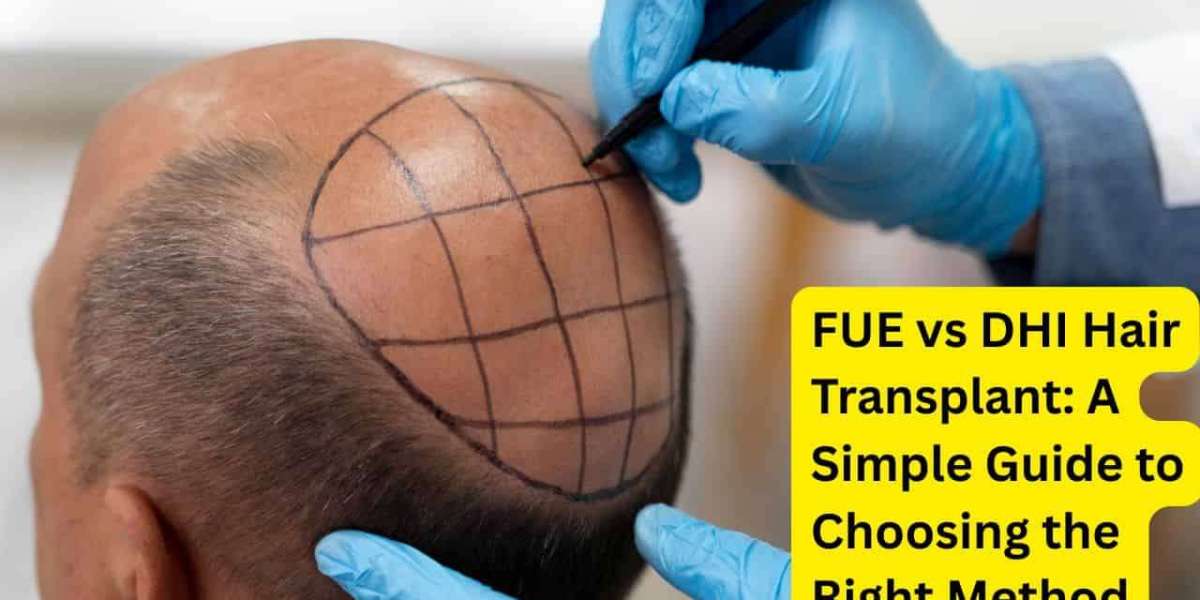If you’re researching modern hair restoration methods, the debate of FUE vs DHI hair transplant is one of the most common topics you’ll come across. Both techniques are advanced, minimally invasive, and widely used in clinics around the world. However, each method works differently, offers unique advantages, and may suit different hair goals and conditions.
In this guide, we’ll simplify everything you need to know about FUE vs DHI hair transplant, including how they work, benefits, drawbacks, recovery, results, and answers to common questions like Is FUE or DHI better?, What are the disadvantages of DHI?, and What is the success rate of DHI hair transplant?
Understanding the Basics of FUE vs DHI Hair Transplant
Before comparing FUE vs DHI hair transplant, it’s important to understand what each technique involves.
What Is FUE?
FUE (Follicular Unit Extraction) is a method where individual hair follicles are extracted from the donor area using a micro-punch tool. These grafts are then implanted into tiny incisions in the bald or thinning areas.
What Is DHI?
DHI (Direct Hair Implantation) is technically a modified version of FUE. In DHI, follicles are extracted one by one—but instead of making pre-created incisions, the surgeon implants the grafts directly using a special implanter pen.
Both techniques offer natural-looking results, but the FUE vs DHI hair transplant debate mainly centers around recovery, density, cost, precision, and suitability.
FUE vs DHI Hair Transplant: Step-by-Step Differences
1. Extraction
Both procedures extract follicles individually.
FUE: Uses a manual or motorized punch.
DHI: Same extraction, but usually with lower transaction rate due to controlled handling.
2. Implantation
This is where FUE vs DHI hair transplant differs most.
FUE: Requires opening channels first, then manually placing grafts.
DHI: Uses an implanter pen to implant grafts directly without prior incision.
3. Time Required
FUE sessions are usually faster for larger areas.
DHI takes longer because each graft is implanted with precision.
Advantages of FUE Hair Transplant
Suitable for covering large bald areas
Shorter overall procedure time
Can be more affordable
Less demanding for surgeons compared to DHI
Great for natural hairline reconstruction
Because it’s versatile, many patients comparing FUE vs DHI hair transplant find FUE more practical for extensive hair loss.
Advantages of DHI Hair Transplant
Higher implantation precision with implanter pens
Better angle and depth control
Higher density possible in smaller areas
Minimal handling of grafts
Faster healing due to reduced incision size
For patients needing dense packing or touch-ups, the FUE vs DHI hair transplant debate often leans toward DHI.
Is FUE or DHI Better?
Many people ask Is FUE or DHI better?, but the truth is—there is no absolute “best.” It depends on your specific needs.
FUE may be better if:
You need coverage for large bald areas
You want a more budget-friendly option
You prefer a quicker overall procedure
DHI may be better if:
You want the highest density possible in a specific area
You have weak or thin donor hair
You are looking for maximum precision and minimal trauma
When comparing FUE vs DHI hair transplant, both methods can deliver excellent results when performed by an experienced surgeon.
What Are the Disadvantages of DHI?
Although effective, DHI has some limitations that people should understand when choosing between FUE vs DHI hair transplant.
Disadvantages of DHI:
Higher cost:
DHI requires special tools and more skill, increasing the price.Takes longer time:
The implantation process is slow because each graft is loaded into an implanter pen manually.Not suitable for large bald areas:
DHI works best for small to medium regions, not full-coverage reconstruction.Requires a highly experienced surgeon:
Poor technique can lead to uneven density.
These points often come up when discussing what are the disadvantages of DHI hair transplant.
What Are the Disadvantages of DHI Hair Transplant?
Here is a clearer, simplified list for users searching specifically for what are the disadvantages of DHI hair transplant:
Limited graft capacity per session
Higher price compared to FUE
Slower implantation process
Not ideal for patients with tight scalp skin
Requires exceptional surgeon control
Understanding these drawbacks helps you compare FUE vs DHI hair transplant more confidently.
What Is the Success Rate of DHI Hair Transplant?
Most reputable clinics report a success rate of 90–97% for DHI hair transplants.
This high success rate is due to:
Minimal graft handling
Faster implantation (less time outside the body)
Precise control of direction and angle
Reduced trauma to the scalp
When evaluating FUE vs DHI hair transplant, DHI is often considered superior in graft survival rate, especially for dense packing.
Recovery Comparison: FUE vs DHI Hair Transplant
FUE Recovery
Mild swelling for 2–3 days
Scabs fall off within 7–10 days
Most people return to work in 3–5 days
Full results in 9–12 months
DHI Recovery
Even less swelling due to smaller implanter incisions
Quicker healing
Faster graft stabilisation
Full results in 9–12 months with higher density in some areas
Both methods have similar recovery times, but DHI can feel gentler because of reduced trauma.
Cost Comparison: FUE vs DHI Hair Transplant
FUE: Usually more affordable
DHI: 20–40% more expensive
Costs vary based on graft number, clinic expertise, country, and equipment used.
Which One Should You Choose? Final Thoughts
Choosing between FUE vs DHI hair transplant depends entirely on your needs, budget, and expectations.
Choose FUE if you want:
Large area coverage
Lower-cost treatment
A tried-and-tested method
Choose DHI if you want:
Maximum density
Natural angles and precision
The highest graft survival rate
Both deliver impressive, natural-looking results—as long as the surgeon is highly skilled.
Conclusion
Understanding FUE vs DHI hair transplant helps you make a confident, informed decision about your hair restoration journey. Both techniques are advanced, safe, and effective, but they serve different purposes. Before choosing, consult an experienced surgeon who can evaluate your hair condition, donor capacity, and long-term goals.














